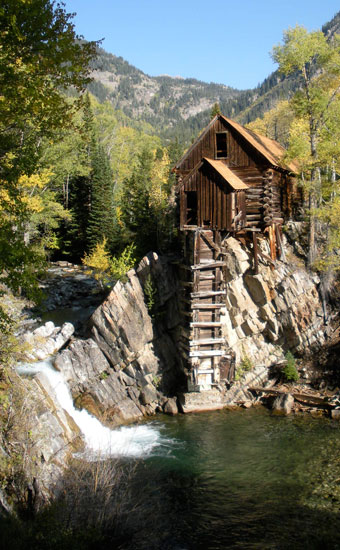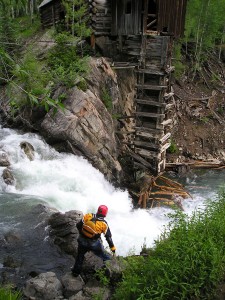 The picturesque Crystal Mill is one of the most photographed sites in Colorado. Its precarious perch on an outcropping of rock just above the Crystal River, framed by beautiful aspens and a backdrop of stunning mountains, gives it an undeniable visual appeal.
The picturesque Crystal Mill is one of the most photographed sites in Colorado. Its precarious perch on an outcropping of rock just above the Crystal River, framed by beautiful aspens and a backdrop of stunning mountains, gives it an undeniable visual appeal.
Though some misinformed people have dubbed it the “Dead Horse Mill”, that name is erroneous and was never historically used. Historically speaking, the Mill was known as the Sheep Mountain Power House, and was located on the Lost Horse Millsite. Today it is known as “The Crystal Mill”.
The mill, constructed in 1893, harnessed the river adjacent to the mill to power the air compressor housed inside. Early engineers had built a dam across the river, which funneled water down the vertical penstock (the ladder-like structure) onto a horizontal wheel, which drove an axle in the penstock. The penstock powered the air compressor. In turn, the enormous compressor ran drills in the nearby Sheep Mountain and Bear Mountain mines. The drills were used to bore holes in the mine walls for the placement of dynamite. Once the dynamite was detonated, the miners removed the ore.
The mill closed its operations in 1917. Continuing efforts to preserve it have been aided by Gunnison and Aspen Historical Societies, residents of Crystal and Marble, and interested individuals caught by the spectacle of the old Mill.
The Crystal Mill is located 6 miles east of Marble, just before the ghost town of Crystal. It is reachable only in the summer and fall months by a rough, one-lane, 4-wheel-drive road. If you are not interested in driving, or your vehicle does not have generous ground clearance, the trip to Crystal and The Mill can be reached by foot, mountain bike, or guided jeep tour. The Mill can also be accessed by horseback, but on a busy summer or fall day, riders will encounter many vehicles and the route is very rocky. There are better places to ride in the Marble area.
